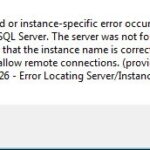Best Way to Configure Firewall for SQL Server Access
Windows firewall is nothing but the software and hardware based network security. It generally controls the transaction traffic mixed up with data packets. Simultaneously it determines whether the upcoming signal is eligible for further routing or not. The threats coming from outside can be prevented with this protective shield. On the other hand, SQL server is a categorized section of relation database management system. Here the data are stored and retrieved to reduce the workload.
Principal steps:
When the basic prospectus is built up then the following factors are depicted at a single stare:
- The main database engine is configured to set a specific TCP/IP port. By default port 1433 is used. But this is also modifiable. Instances of the SQL server can be arranged dynamically.
- Next the firewall should be configured to make the privilege settings to access the port. Authentication is verified digitally before giving the permission.
Procedures in Hand:
After researching on several analysis the below mentioned steps are found necessary. To open the port in firewall service for transfer control protocol access like:
- In the window of control panel, the network connection option is opened. After right clicking the active connections, one should select the properties tab.
- Then there the advanced tab is clicked. Windows settings for firewall are then followed through.
- In that dialog box the exceptions tab is clicked upon. Then a port can be added.
- In the textbox of port number, the number extracted from database engine is typed. By default 1433 is written.
- Then the verification is started on selected TCP. Process will be updated by saving these via OK button.
- Now for SQL server’s exposure in browsing, a port must be added. Here the name textbox should be filled up with SQL Server Browser. Corresponding port number is 1434. Additionally UDP must be weeded and updated.
- The windows firewall and the tab of properties are then closed.
Actions for dynamic ports:
If the user does not want to use TCP server, then there must be the options to work with dynamic ports. To build up this configuration some steps are there to implement:
- From the start menu, WF.msc is run through the specific tab.
- In the advanced security mode of firewall, inbound rules are right clicked in left pane. Here the new rule can be added.
- Later the rule type box is selected. Then it is followed by picking up program.
- Here the program path is delectated. Navigation to the instance of Microsoft SQL server is browsed to access proper firewall.
- In action tab, the connection is allowed.
- In profile dialog, a short description is composed on connection environment.
- Finally the process is finished by fixing the name in associated textbox.
Conclusion:
If the integration of firewall with SQL server has to be established then some well researched techniques like mentioned discussion should be performed. It provides an entrusted service with encrypted security. So the posterior fragment can be epitomized by configuring this connection based on robust architecture.
Author Bio: Brianne is a writer/blogger. She loves writing, travelling and blogging. She contributes to Julie Brown Plastech





